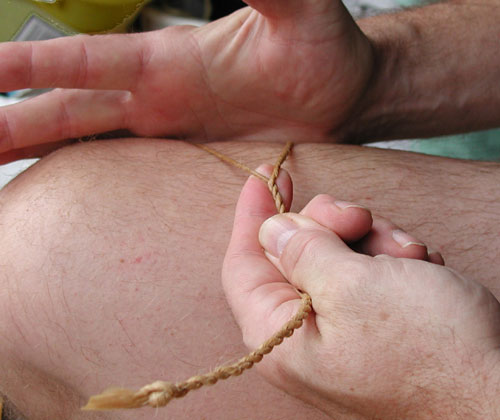
This page results from a workshop I did at the Council of Outdoor Educators of Ontario (COEO) Conference in September 2004. At the usual COEO auction, Dr. Zabe MacEachern, of the Outdoor and Experiential Education department of the Faculty of Education at Queen’s University, bought my workshop services. So in January 2005, I will take her students through a session of twine-making (and fire-making) as an example of using crafts to better understand a lifestyle. (Thus this page is incomplete until after that session, when I’ll have more pictures of the actual twining process to add.)

I have used crafts, even mundane simple crafts such as twine-making, to better understand the lifestyle of gatherer-hunters. While my specific interest is in Southern Ontario pre-history, I believe these lessons apply anywhere in the world — my Stone-Age ancestors somewhere in northern Europe very probably did similar things with twine.
We know peoples such as the Huron of Southern Ontario are reported to have had fishing nets of a hundred metres or more, made preferably of wood-nettle fibre, but also from basswood. We know also that fish was the major source of animal protein for the Huron. So twine production and use were of great importance to them.
We have some tantalizing hints that some of the earliest people in this hemisphere may have used twine nets as a major part of hunting big game such as mammoths and mastodons, ensnaring and immobilizing them with nets before killing them with thrusting spears.
We know that on many aboriginal archaeological sites in North America, plant fibre and twine are a major and often overlooked component. (Do an internet search on James M. Adovasio and twine, for starters.) The oldest twine found any where in the world dates back nearly 20,000 years, though evidence points to a much earlier development of the skills of making and using plant fibre for twine production.
Clearly, twine-making is a foundational skill for gatherer-hunters — and, I suggest, for early agriculturalists, as well. It is a learned technique to produce a material used in many different ways, ranging from nets and bags, to weaving and sewing, to making snares and bow-strings, to the multitudes of mundane uses of string and twine in tying and securing simple bundles. I believe learning how to make twine and then to use it can be an insightful way of better understanding the lifestyle of gatherer-hunters.
Through directly doing the sequence of tasks associated with twining, I have come to understand and appreciate something of the knowledge and the skills required. I marvel at the depth of their knowledge and understanding of their environs. I have learned about the amount of time and of energy involved. I have some practical understanding of the social contexts in which the skills were learned and practiced. The annual timing of the component activities begins to make sense to me.
In making twine, there isn’t the inherent thrill that I get when successfully producing fire-by-friction. I can quite easily produce twine of a quality and at a rate that I think any self-respecting 10-year-old gatherer-hunter would be satisfied with. But just as my favourite prehistoric tool is an old Archaic-period ‘kitchen-knife’ blade — because it is so ordinary, and could well have been a favoured tool of some ancient woman — twine-making is very satisfying to me. The significance of how much twine had to be made, of how much time they must have put into just twine-making and net-making alone, of what other daily tasks would have been done at the same time — all these learnings give me a much better understanding of what it might have been like to live in gatherer-hunter times. (The more I think I know, the more I’m glad I’m living now ...)
What I know about the preparation of basswood for twining is based on perhaps ten sentences from various books. Only one, Frances Densmore’s ethnobotanical work (the Dover reprint is titled How Indians Use Wild Plants for Food Medicine and Crafts ISBN: 0486230198, Dover Publications), is based on direct ethnological observation. The rest fall into the category either of old ‘woodcraft’ books, or slightly newer ‘abo-tech’ manuals.
There is more extant information about the twining process itself — but not much more. Until recently, the only thigh-rolling I’d ever seen was a very grainy ten-second black-and-white clip of Louis Leakey rolling some vines into a crude and immediate rope.
The rest of what I have learned has been from doing this myself with students, especially learning from omissions and mistakes — and triumphs! — of mine and of my students.
So this web-site seeks to add somewhat to the literature, especially through the photographs. I hope, also, that the extra tidbits of history and natural history are of value. I hope the most valuable is the approach of using a craft such as twine-making as a window into a lifestyle through direct involvement and consequent querying and analysis.
Basswood (Tilia americana) is a common tree in the river lowlands of my part of Southern Ontario. It was used by the local aboriginals in a variety of ways. Iroquioans used the soft easily-carved wood for masks. The inner bark was one of the preferred sources of ‘bast’ — plant fibre — used for all manner of cordage uses, ranging from quick-and-dirty strip-off-a-branch thonging to tie a rough parcel, to being used for very fine twine which was then woven into thick strong door curtains.
(I knew how to identify basswood for almost twenty years before I realized that the name ‘basswood’ comes from a corruption of ‘bast-wood’, that is, ‘fibre-wood’.)
As a source of basswood fibre for teaching, I remove the bark from basswoods cut as part of trail-maintenance. I ‘cheat’ (in terms of a total understanding of a gatherer-hunter lifestyle) by using a steel axe. I cut the tree down, and remove the bark when the tree is lying on the ground. I have not yet tried using a stone tool to cut the bark on a living vertical tree and then strip the bark upwards. That would require more energy and time than the ‘cheating’ method I use, but it would also be more realistic for better understanding people without steel axes.
Basswood bark ‘slips’ or peels off very easily in May and June, when the tree is still actively growing and the cambium is still very active. The cambium produces a very mucilaginous slime between the wood and the bark that makes is relatively simple to separate the bark from the wood.
Cutting down a 15–20 cm tree with an axe takes five minutes, involving quite high energy and moderate skill. Peeling the bark requires low skill, but requires a high output of energy. It is fairly easy to remove the bark from the main part of the trunk, but removing the bark from the branches is more difficult. Since three-quarters of the bark is on the trunk, it has never made sense to me to take a lot of time and energy to get all the bark off the tree.
Choosing the ‘right’ tree (straight and unbranched) actually takes the most time — though through the year, I usually keep my eye open, noting appropriate trees, and then remembering where to go when it’s time to harvest the basswood bark. Since I am generally removing trees as a part of trail maintenance, I obviously kill the tree. I suppose it might be possible to only take a portion of the bark off a tree, leaving the tree to heal itself. In practice, that I would think that would only work on large trees. My limited experience is that the inner bark from younger smaller trees is better, in that it is more even, and less likely to be coarse, ‘webby’, and woody.
I rot (‘ret’) the basswood bark by submersing it in a stream for a period of time. The retting serves several purposes. Firstly, the rotting action of the bacteria and other organisms makes the separation of the unwanted outer bark from the desired inner bark very much easier. Secondly, the retting also breaks down the pectins that form the glue that binds the plant fibres together, and makes the resultant fibre softer, thinner, and perhaps a bit less slippery. (Note that for some purposes, i.e., fishing nets, slippery fibres might be desirable, in that the fibres would be easier and less abrasive to handle.)
The ethnobotanical literature reports a variety of approaches to this stage of fibre preparation. Frances Densmore, the woman who worked with the Chippewa in the Boundary Waters area of Minnesota bordering northwestern Ontario over a century ago, reports that the women (note the gender) buried the raw bark in a swamp for a bit over a week, and then peeled the inner layer off. They then boiled the inner bark in a pot of wood ashes and water, i.e., in a weak lye or alkaline / basic solution. They followed this chemical digestion by physically pounding the retted and boiled fibres with a wooden maul to separate the fibres. I have tried that process ... It was very slow tiring work, requiring a lot of effort. It produced coarse and gummy fibre that I was not impressed with.
The next year, during the retting stage, I was distracted by a newly born baby. I left the bark to ret for three weeks (over twice what Densmore reported). I feared that I had ruined my bark supply. When I pulled the retting fibre out of the river, I was sure I’d lost everything — it stank so strongly! But when I started cleaning the fibre (see below), the resultant material was finer, more uniform, and much softer than anything I had produced by retting, boiling, and pounding. And it was much easier work! ... I’ve continued the lazier approach since then! ...
This all raises very important questions. Am I following any sort of authentic methodology? Is my twine truly better under full use? If my way produces better twine, why did less ‘efficient’ methods continue? What are the factors that would dictate one approach being used over another? Did they use a multiplicity of approaches, depending on need and timing? ...
I have learned that the most efficient way to organize prepared bast is in fairly short strips, bundled together in parallel, so that the prepared fibre stays organized, instead of getting tangled and therefore becoming useless. So, while it feels great to be able to strip a seven-metre-long strip of bark off a tree, I’ve adopted the practice of cutting the bark pieces into approximately 1.5 metre pieces, and then piling them together. I wrap the bundles with the smaller pieces of bark stripped off small branches. Then I submerge the bundles of tied bark in a small pool of the trout stream. I hold the bundles down with pieces of wood wedged so as to prevent flood freshets from carrying my precious material away.
I leave the bark three to five weeks — and don’t particularly notice that the five weeks is too much. I might get even lazier ...
There are various other approaches reported. Some tribes peeled the two barks apart directly as they they removed the fibre from the tree. Others didn’t ret biologically at all. Others boiled the inner bark in water only. I’ve not come across reports of multiple ways of preparing bark within one family group. Did they by and large only use one approach per tradition? Or were multiple approaches overlooked by early investigators, most of them male and not much interested in something as mundane the work of women and children in fibre preparation?
I wonder whether my invented technique — something I stumbled upon accidentally, rather than purposefully invented, but then fervently accepted — in any way reflects what may have happened in gatherer-hunter times?
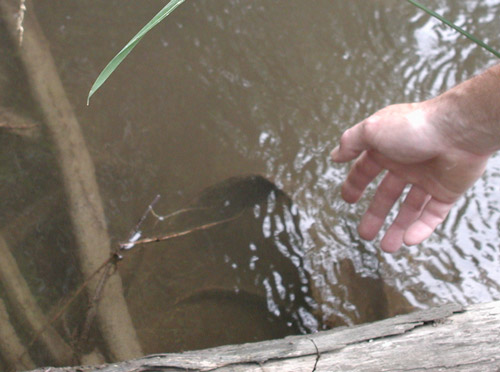
You can see some of the wrapped bark, as well as the pieces of wood jammed in to hold the bark submerged. What is more difficult to see is that much of the bark has been covered by storm-deposited silt and sand —to no bad effect.

Deliciously slimy and stinky retted bark — as it looks when first pulled out of the water. The stench (which I now sort of like ...) takes about three days to wear off my hands and arms.
(I believe I once got a giardia infection by putting (washed and dried) bast in my mouth to soften it. I don’t follow that time-honoured approach any more ...)
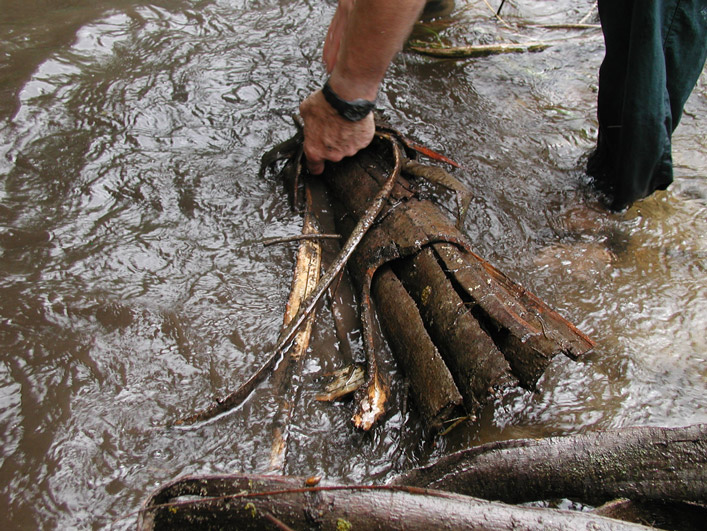
A bundle of short 1.5 metre pieces of bark from the trunk of the tree — the easiest to remove from the tree, and the most efficient to work with at every stage of twine-making. About three-quarters of the usable bark off trees come this way, if you chose an unbranched tree. Worthwhile!!

Cleaning the thick black biological slime off the bark preparatory to separating the useless outer bark from the desirable inner bark.
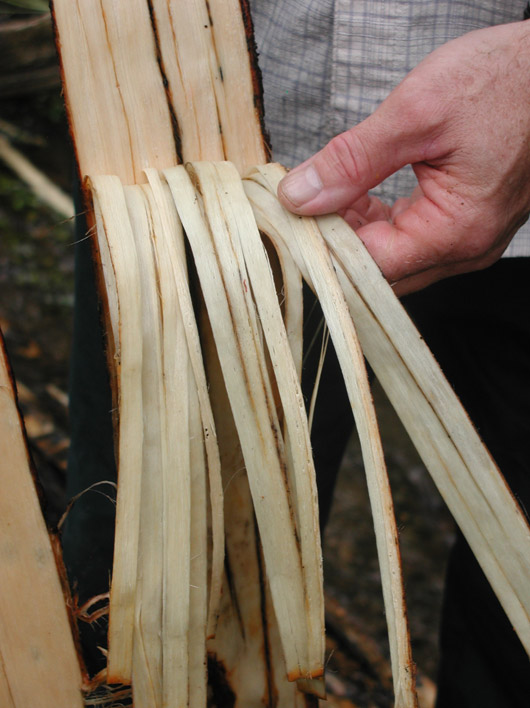
Several things to note in this photo: a) the stiff and useless outer bark at the top of the photo; b) the white inner bark hanging down; c) the way the inner bark breaks into both layers (the annual rings of phloem) and strips — both are fine, and no cause for worry. This is great fibre! d) You may be able to make out what I call the ‘webbiness’ of one of the narrow strands hanging down in the centre. It doesn’t look as smooth as the rest of the inner bark. This is older inner bark, towards the outside of the tree, and has been stretched as the tree expands in circumference. It is generally tougher and woodier than the newer inner bark close to the wood, which is softer and finer material. I don’t try to salvage all the webby inner bark as I’m stripping the inner from the outer bark. Twenty per cent of the effort and time produces eighty per cent of the useable material. (We didn’t discover that rule in the Twentieth Century — it’s been understood for a long time!)

More views of separating bark.
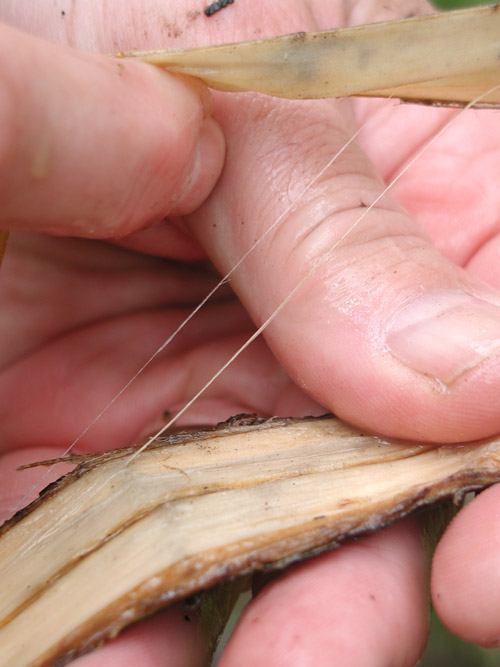
The desired inner bark is the phloem of the tree. On a simplistic level, the phloem serves to transport water and plant products from the leaves (where the products are made) to the rest of the tree. (The outer layers of the xylem — the wood — transport raw materials in the reverse direction, as well as providing the support for the tree.) Phloem is made up of long slender heavily-lignified cells that are glued together with pectins. It is the biological and/or chemical and/or mechanical processing that separates the inner phloem from the other outer corky material that makes up the protective outer bark of the tree.
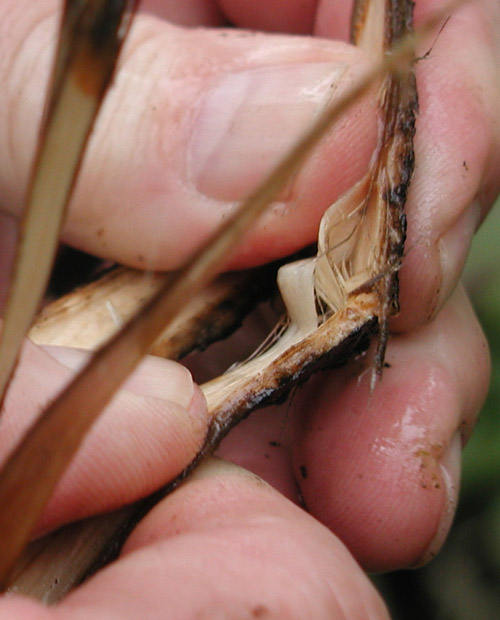
We are all familiar with the annual layers of xylem laid down as the annual rings of a tree. These layers are produced each spring and summer by the cambial layers between the wood and the phloem of the inner bark. That same cambium also produces annual layers of phloem that are easily visible in these photos.
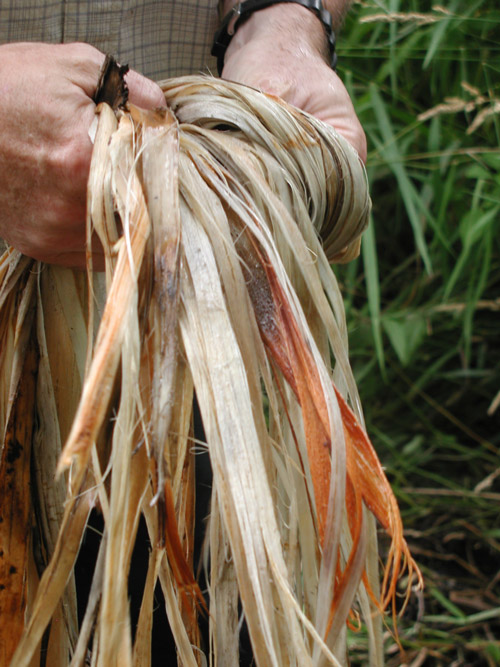
Note the various colours of inner bark stripped mostly from upper branches. This is good fibre, but tends to come in shorter and variable lengths and is often somewhat coloured, particularly the lovely reddish colour. That reddish colour is always only on the exposed inner surface of the bark where the active cambial layers are. The best guess I have for the cause of the colouration is some artifact of retting acting on the active cambial tissues. Unfortunately, the colour fades to a nondescript brown that doesn’t really last.
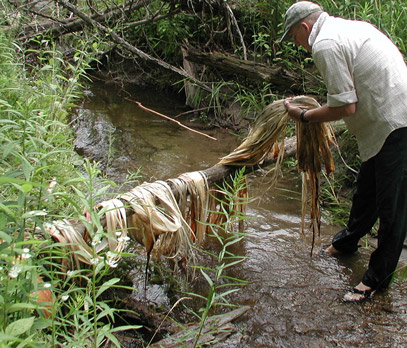
I strip the bark off, and wash it well in the river, trying to keep it organized, rather than tangled and jumbled.
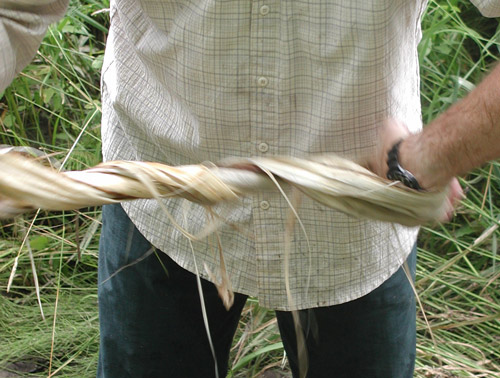
I take the bark and twist it into hanks for easier storage.

I’m happy, but you wouldn’t really want to smell me ... I hang these hanks of fibre outside in the sun and rain for several weeks to further minimize the smell and to dry them out before storing them. The big hank on my right arm is all from the trunk, and is all pieces about 1.5 m long. It’s the most usable fibre.
It took about one hour of smelly but low-energy and low-skill work to clean and separate and organize this amount of fibre. The worst part is often coping with the bugs — but this year, neither the mosquitoes nor the deer flies showed up.
My guess would be that this amount of fibre from one 15 cm basswood tree would perhaps make a fishing net of about five metres by two metres ...
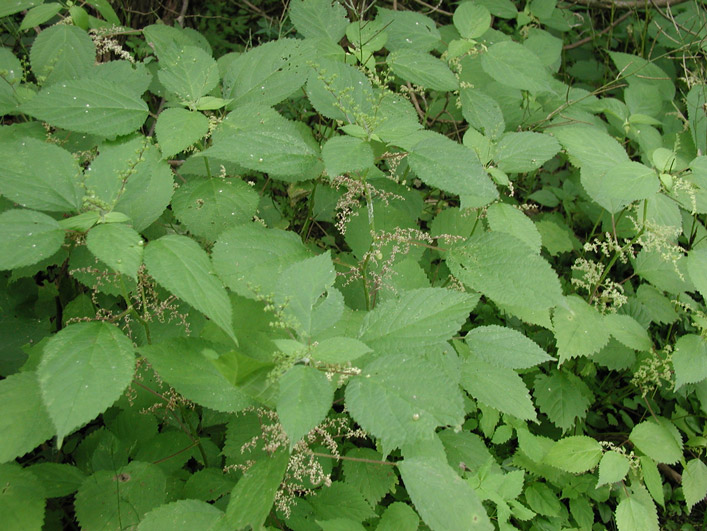
Wood nettle, Laportea canadensis, also growing in forested floodplains with basswood, was reportedly the favoured bast fibre of the Hurons for use especially in fishing nets. Each extended family is reported to have had one or more nets of up to 100 m or more in length. Wood nettle reportedly makes very strong yet soft and supple nets, especially important in the cold waters of pickerel spawning season.
I have never processed wood nettle, despite working in an area with a profusion of the plant. The plants were reportedly gathered in late fall, as the autumnal frosts are killing the plants (and destroying the stinging hairs), but before they were downed to rot by early snows on the ground. Some reports talk about soaking in water (i.e., retting), before pounding to remove the woody parts of the stem. Various sources talk about some kind of combing to remove the woody bits as well. This process is very much analogous to the processing of flax into fibre for linen.
In the early 1600’s, the New France French, many of them fishermen from Normandy and Brittany, saw a business opportunity in providing the Huron with French nets — which the French were sure were of superior quality, being civilized French, of course. Sure that the Huron would be grateful for anything French, they brought over what were in fact cheap and nasty nets from France that were terribly rough and tore the hands of the Hurons in the cold spring waters of Georgian Bay and Lake Couchiching. The Hurons saw these poor French nets as yet another proof that these boors with hair on their faces were uncultured heathen, and not worthy of serious consideration. A classic case of bi-directional cultural misunderstanding!
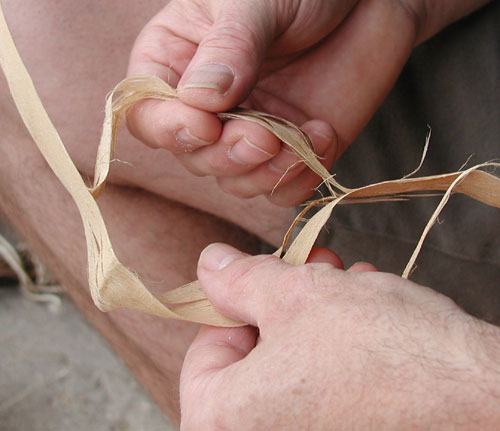
I make twine made from the inner bark of basswood. This twine will not be durable enough for some uses such as a bowstring for a fire-bow — even though it’s strong enough to lift my 110 kgs. Basswood twine is not resistant to the wear and tear of rubbing, so it would not be the expected material in a friction-producing situation.

Twining fibre in this ‘z-twist’ manner is a technique that humans have been using for tens of thousands of years. I am using the thigh-rolling technique here — the method generally used by women, since it’s much faster and more efficient than the alternative of finger-twisting. Huron families had fishing nets perhaps hundreds of metres long made of basswood twine, or their preferred wood-nettle.
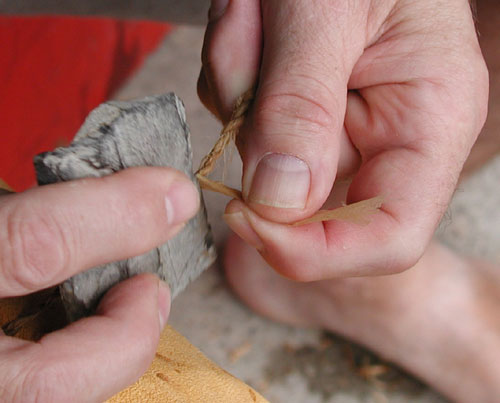
I’ve often noticed when students work through the various steps of making twine that they still continue to chat with each other about on-going daily matters. They tell stories. They sing. They talk about this topic and that topic not in the least connected to twine-making. No matter what their frustrations are with learning the various twining methods, coping with fingers not used to working in the particular ways required, and struggling to keep the mental map of the developing net despite the tangle of misbehaving twine, they keep their social lives going.
But when I ask them to consider whether the people they are emulating were caught in a desperate struggle for existence, or instead constituted the original leisure society, they don’t often make the connection. They’re struggling with a small and simple component skill, and have difficulty placing that in context.
If I ask them to describe to me their imagined surroundings as a pre-historic family group, then they develop a better picture. Who would you be working with? What tasks would the others with you be doing? Since I work with older teenagers, I ask them where their children would be, and what would they be doing? I get them to picture the smoky winter interiors of the longhouses they are excavating, and to recreate the smells, and the stories, and the activities. (Why winter? The Hurons preferred wood-nettle for fishing nets. Wood-nettle is harvested in late fall, and is then retted. So the processing season would be in the long winter moons, during the intensely social winter confinement.)
Would specific people have specialized in certain jobs? Would girls and younger women have done most of the actual twining? If so, what would the similar cohort of boys and young men be doing? Would only certain individuals have done the net-making? Who would they as young adults be instructing? Who would be over-seeing their actions, determining what’s to be done next, and when the task is finished satisfactorily? What criteria would they use to determine when a particular bit of twine was properly made? Were standards based on utilitarian what-worked criteria? Or did tradition dictate to what standard and with what approach work was done? How many styles of twine-making would they have? When might they use the different approaches? How did the various standards mesh with the matrilocal pattern of habitation of the Hurons? When and by whom would the preparatory work be done? When and how would the finished net (in this case) be used? Who would use the net — as opposed to who would make the twine or make the net? How long would a net last? How were repairs effected? What other questions can you raise?
So I’d attempt to get the students to consider these questions and others they’d raise themselves, seeding several questions and thoughts at a time into their on-going chatter. Would the prehistoric people have considered twine-making ‘work’? Given the amazing amount of twine they required, would the consequent amount of time have been an issue? Would they have spent concerted periods of time making twine and nets, or would those tasks have been distributed more freely, a bit now, and a bit then?
For me, this whole exercise of making basswood twine gives me what I think of as significant insights into the lifestyle of a person living ‘in the land’ — a much fuller understanding of their relationship to the environment around them. The value for me is not in producing the fibre, though that’s a satisfying feeling. It’s in more directly understanding how fully our ancestors had to integrate all aspects of their existence in order to live.
E-mail me at: markwhitcombe34 at gmail dot com
updated 2004 November 30